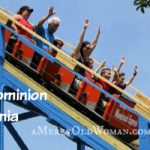Frontier Culture Museum in Staunton, Virginia is a living history museum that preserves and celebrates the influence of pioneering immigrants on our early American roots.
We were traveling through the western part of Virginia, and we had some extra time in our schedule that we wanted to fill. Although we were not sure exactly what we would find, we discovered a hidden jewel when we decided to make a stop at the Frontier Culture Museum.
FRONTIER CULTURE MUSEUM
America! A land of opportunity and new beginnings! Settlers from England, Ireland, and Germany filled up the empty countryside of a newly discovered continent with villages modeled after their native homelands. Heavily influenced by local Native American cultures, they tamed the wilderness and pioneered a new way of life. Equally important, and not to be overlooked, were the contributions of West Africans. They brought their own unique traditions and knowledge to the New World.
The Frontier Culture Museum preserves the story of these early immigrants. But this is not your ordinary museum filled with old equipment, old clothes, and faded old photos behind glass walls. Instead, the museum is a living community. Moreover, it showcases the lifestyle and architecture of the eighteenth century villages of these different cultures. To that end, most of the buildings are actual homes from that time period that have been brought to this location and painstakingly reconstructed.
Villages
The American colonies were founded by England. Not surprisingly, English immigrants flooded the new continent by the thousands. They brought their culture and their way of life and established towns and villages. The house is a typical home of a yeoman farmer in England’s West Midlands.
In the 1700’s, Protestants from Ireland and Germany migrated to America in large numbers. The Irish farm is a typical Presbyterian household in Ulster. And the German farm is characteristic of a classic Rhineland farm in the eighteenth century.
The Ganatastwi, which means “small village”, represents the Native people who inhabited the area of the eastern seaboard. Without the help and generosity of these people, it is doubtful that the new colonists would have survived and prospered. The bark hut is a typical home in a Native American village neighboring the new colonial settlements.
West African people were enslaved and brought to the colonies beginning as early as 1619. Thousands more were brought over during the following centuries. Their traditions, culture, and knowledge, as well as their labor, contributed to the success of the new frontier. The house is typical of the people who lived in what is now southeastern Nigeria.
By the 1740’s, settlers were pushing the boundaries of established society and settling on the very edges of the western frontier. They hacked their homesteads out of the wilderness and built their homes out of logs.
By the mid 1800’s, America was prospering. While civilization continued to push further and further west, settlers in the heartland of Appalachia were rewarded for a generation of hard work and sacrifice with comfortable homes and thriving farms.
Village People
NO! Not THOSE Village People! I’m talking about the docents – the inhabitants of the villages. As fun, interesting, and unique as the houses are, they are just empty buildings without that special spark that makes you want to linger on a hot summer day. But add a costumed villager and the whole experience changes!
Somehow, the Frontier Culture Museum has managed to transport a 16th, 17th, or 18th century settler to the village. These people are the genuine real deal. They are the actual living personification of our ancestors. They are friendly, and entertaining, and bring a personal element to the history lesson that cannot be duplicated. From the Irish homemaker spinning and weaving, to the blacksmith making a belt buckle, to the backwoodsman telling a story, to the farmer fiddling a tune, the villagers pull you back across time into their world with a look, story, or song.
But beware! Once you step through the portal into their world, the villagers not only teach you something – they then put you to work doing it. YES! This is a hands-on history lesson. The woodsman teaches you how to properly cut a log. The English farmer teaches you how to cut grass using a scythe (yes that’s me cutting grass!). The school teacher teaches you how to use a slate board. And if you misbehave in her classroom, she might make you get up and recite the ABC’s in front of the class.
All in all, the Frontier Culture Museum is a great place to spend a few hours – or all day – learning about our early American culture. Make sure to put it on your bucket list.
IF YOU GO
Be advised that the villages are spread out over several acres. Therefore, be prepared for quite a bit of walking. For this reason, golf carts are available for rent. However, you better get there early if you want to grab one.
Although we had originally planned to spend 2 hours at the Frontier Culture Museum – surprisingly, we ended up staying over 4 hours!! We certainly had fun and managed to fill that extra time in our schedule!
To sum up, the Frontier Culture Museum is located in Staunton, Virginia. There is a small fee to get in.
Pack a picnic lunch and enjoy the beautiful picnic area.
Be sure to watch the calendar for special events.
For more information, contact them at www.frontiermuseum.org
Finally, I’ll leave you this one last photo to show what a great time we had. Our grandkids jumped into this canoe and immediately decided to recreate this famous painting. American history at it’s best!
Have you been to the Frontier Culture Museum? Tell us about it!












Leave a Reply